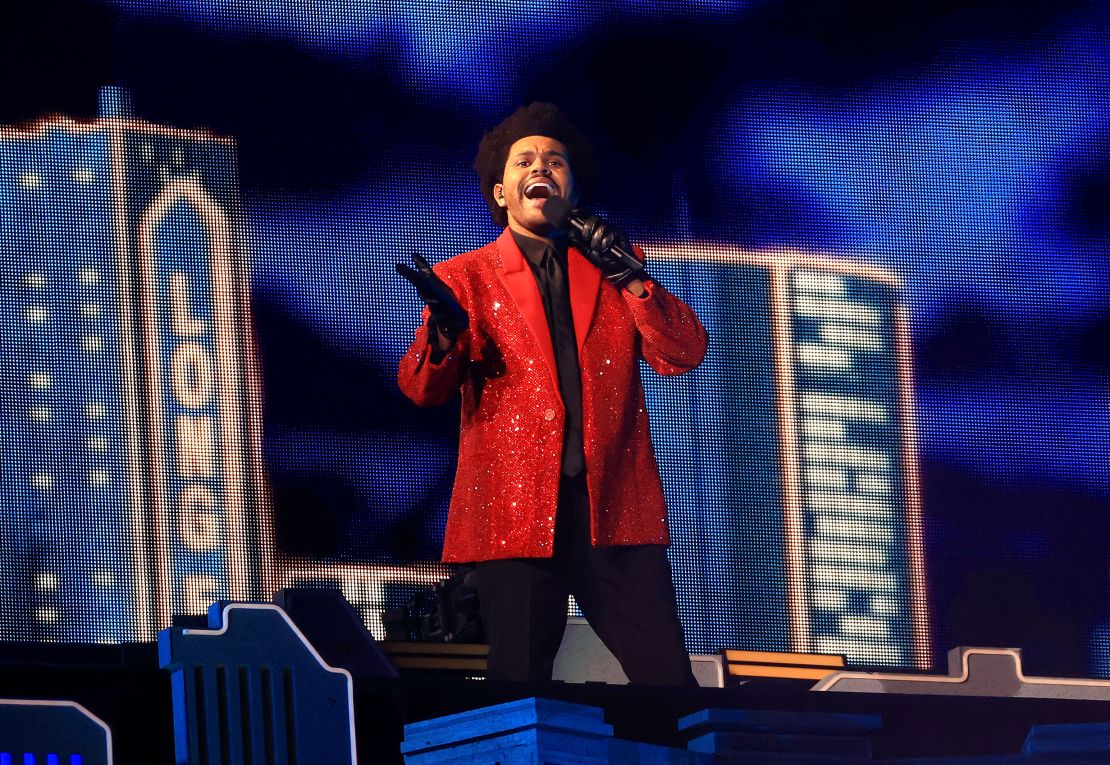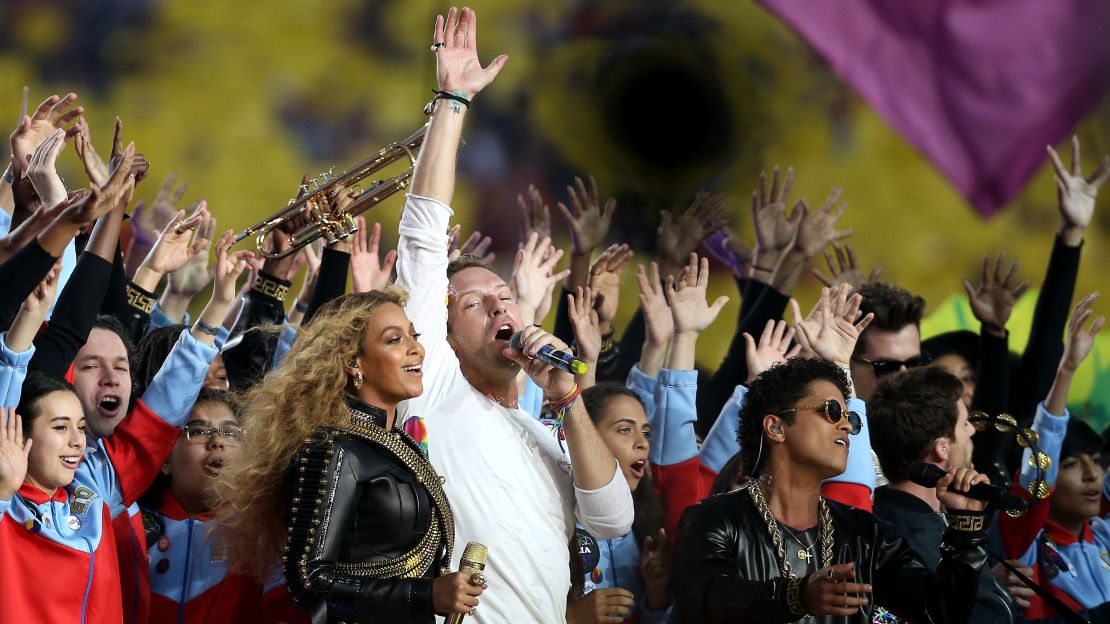The sports world is rightly raving about Tom Brady securing a seventh Super Bowl title on Sunday, as the Tampa Bay Buccaneers breezed past defending champions the Kansas City Chiefs.
But when Brady trotted off the field at halftime, he ceded center stage to a man calling the shots for a 12th Super Bowl in a row, and whose decisions will be discussed, debated, and were perhaps even danced along to.
READ: Tom Brady says he’s open to playing past 45 ahead of his 10th Super Bowl
Never mind the action on the field at the NFL’s showcase game, for many, this weekend was all about The Weeknd. And the man who helped bring the pop megastar’s Super Bowl LV halftime show to life is a British TV director named Hamish Hamilton.
Since 2010’s The Who-headlined spectacle, the now 54-year-old, award-winning Hamilton has been involved in showcasing musicians so famous we know them by a single name – Madonna! Beyoncé! Gaga! – or bands that have soundtracked a generation, such as Coldplay, Maroon 5 and the Black Eyes Peas.

Global interest in the halftime show is nothing new, though 2021 does mark the 30-year anniversary of the NFL changing course from traditional marching bands to contemporary music acts – and what a change it was.
Super Bowl XXV – also held in Tampa – kicked off with a sublime rendition of the Star Spangled Banner from none other than Whitney Houston.
Halftime was billed as “A Small World Salute to 25 Years of the Special Bowl” featuring New Kids on the Block, though events of the day would intervene.
Operation Desert Storm resulted in the show being tape-delayed until after the game with a Gulf War news report shown instead.
READ: Check out all of CNN’s Super Bowl coverage
It was a watershed moment and the league never looked back, booking household names such as Michael Jackson, Diana Ross and Boyz II Men in the 1990’s.
The Aughties witnessed U2’s cathartic post-9/11 performance, the infamous Janet Jackson and Justin Timberlake “Nipplegate” incident from 2004, and Prince in 2007 – often cited as the greatest halftime in history.
All these performances were seminal moments before Hamilton took the reins in 2010.
The audience has even eclipsed the viewership for the game itself at times: in 2015, Katy Perry and her colorful companions attracted 118.5 million viewers, compared with the average game audience of 114.4 million.
From Blackpool to the Super Bowl
For Hamilton, raised in the north of England in the 1970s, the very notion of the Super Bowl, let alone the halftime show, was literally as foreign a concept as he could contemplate, with his paying more attention to English, rather than American, football.
“I grew up in Blackpool,” Hamilton tells CNN Sport in a rare interview. “These are the days before the internet and mobile phones and global sharing of media. My only knowledge of sport really was my local football team Blackpool, and many miles away in the big city, Liverpool, who at the time were dominating European football.”
Hamilton attracted attention from America after directing numerous BRIT Awards – the UK equivalent of the Grammys – and while he has the Opening Ceremony of the 2012 London Olympics and the Oscars on his resume, helming the Super Bowl halftime show is, well, the Super Bowl of his career when it comes to the cultural zeitgeist.
“We always looked across the Atlantic to this undiscovered land of opportunity and excellence,” he says. “Now, for me to be creating these enormous shows at the very epicenter of American culture fills me with enormous pride.”
The logistics involved in mounting the halftime show are arguably as tricky as trying to win the Super Bowl itself.
Many months, involving many people – halftime was also co-executive produced by Shawn “Jay-Z” Carter’s Roc Nation – go into the planning, and the song, if you will, remains the same: turn a football field into a concert venue and back in under 30 minutes.
Hamilton acknowledges that each headliner is different when it comes to the time they spend collaborating, but “they have a vision, and our role is to bring that vision to life. At the end of the day, the mission is to create 12 minutes of entertainment halfway through this football game in February.”

READ: The Weeknd set to headline Pepsi Super Bowl LV Halftime Show
Hamilton is acutely aware how much this gig means to the musicians – “a career-defining moment and a huge part of their artistic legacy” – against the backdrop of multiple challenges.
“You’ve got to push a stage out in seven, eight minutes, put it all up, build it, and take it down,” Hamilton says. “In a world that’s fracturing, it’s a great lesson in what people can build under tremendous stress when they work together and place trust in each other … It’s extraordinary.
“It’s an adrenaline rush roller coaster and honestly, you spend 12 minutes focusing, just trying to keep the train on the track, and deliver what everybody wants you to deliver.”
READ: A look back at the best Super Bowl halftime shows and fashions
Covid-19 concerns
Delivering this year’s show was a monumental task, with the coronavirus pandemic looming large over proceedings, despite the vaccine rollout across the nation.
The 25,000 fans in attendance were required to wear face coverings at all times and received PPE kits, a Super Bowl branded face mask, hand sanitizer, and wipes from the NFL on arrival.
The impact on the halftime show was considerable. This is, after all, an event which involves a multitude of performers on stage and where social distancing is the very antithesis of what tends to be a highly coordinated and packed affair.
Hamilton refused to give anything away, though did admit that “it has put a very different set of parameters around the production. [But] we have risen to the challenge in the same way we rise to the challenge every year, so I guess all I would say to everybody is, ‘Tune in and make your own judgment.’”
But The Weeknd (real name Abel Tesfaye) did confirm beforehand that “we built the stage in the stadium,” while executive producer Jesse Collins told Entertainment Tonight, “We’re going to use the stadium to present the show in a way that it’s never been presented before.”
The acts are savvy enough to reportedly perform without a fee from the league – because the intense interest generated through appearing pays for itself – though the NFL does supposedly supply a budget.
And while Hamilton wasn’t willing to divulge details, The Weeknd’s manager, Wassim “Sal” Slaiby, told Billboard magazine that his star client put up $7 million of his own money to “make this halftime show be what he envisioned.”
For his part, when speaking to CNN Sport and the rest of the assembled virtual media on February 4, The Weeknd did refer to putting his hand in his pocket.
“I don’t think I have enough money ” he joked when it was put to him that wasn’t too late to incorporate the usage of a helicopter, which is what his favorite halftime performer ever – Diana Ross – did to conclude her show in 1996.
READ: The evolution of the Super Bowl halftime show
When Hamilton speaks about his halftime show memories, the sporting parallels with the sides contesting the Super Bowl emerge. Reflecting on the many major acts he has worked with, his observations about Coldplay’s frontman evoke a team player, rather than individual talent who doesn’t want to share the ball, or rather stage.
“Chris Martin is the most generous of artists,” Hamilton says about his fellow Brits Coldplay headlining Super Bowl 50 in 2016. “So he rings up his mate Beyonce, he rings up his mate Bruno Mars, and he literally persuades them.
“They were both a bit reticent at the beginning and he’s like, ‘Come on guys!’ And so Beyonce turns up with a hundred dancers, and Bruno turns up with his entourage. And what a great show it was … That came together pretty last minute, in a dance studio behind a laundromat. If people knew what was happening in this tiny little dance studio, they would be shocked.”

But if you can take the boy out of Blackpool, you can’t quite take Blackpool out of the boy. Hamilton casts his eye back toward his native Britain and poses the question about whether English football would ever take a leaf out of the NFL’s book and add an extra layer of entertainment to proceedings.
“I was a football fan as a kid, I used to watch the FA Cup, and that was the big thing in the calendar,” he says about the closest comparison to the Super Bowl in England.
READ: Tom Brady vs. Patrick Mahomes is a Super Bowl matchup that spans the ages
“It would be great if the FA decided to do a halftime show and a pregame in the same way as the NFL. The NFL have been brilliant, they’re very supportive of halftime, and they really invest financially, creatively and logistically in creating this centerpiece at halftime.
“It’s the marriage of sport and music and entertainment and it really, really works. I don’t think there’s a better example of it in the world.”

























